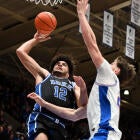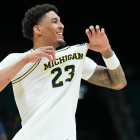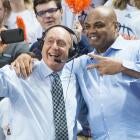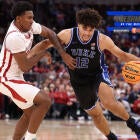2019 NBA Mock Draft: Knicks get Zion Williamson, but Cavaliers pass on Ja Morant for RJ Barrett
The stars are aligned for Duke players to go in the top two slots in Kyle Boone's latest NBA Mock Draft
Let's take a big-picture look at the NBA Draft. How big? Well, consider that the great astronomer Galileo Galilei once described the Milky Way as "nothing else but a mass of innumerable stars planted together in clusters."
He was talking, of course, about the galaxy that contains our solar system -- the sun, the planets around it. But he may just as easily have been foretelling what the NBA Draft class would look like centuries later in a post-NCAA Tournament landscape in 2019. Mass of stars, all in clusters, perhaps on a slightly smaller scale. Perhaps.
There's Zion Williamson, Duke's one-and-done phenom that is already in a unique galaxy unto his own. Then in this class there's Ja Morant, RJ Barrett and everyone else lumped together in the same draft-eligible solar system. Innumerable stars await their NBA fate as the draft looms in late-summer, but now, we wait and watch to see how the draft process evolves as teams begin working out prospects, gathering intel and shaping their boards.
With the early entry deadline now officially in our rearview, we can finally begin sifting through the names that have declared and get a sense on where team needs will lie this summer and which positions franchises will target to address via the draft. The order is subject to change with the draft lottery still looming on May 14 and the withdrawal deadline two weeks after, on May 29, but before we hit those checkpoints we've put together an updated mock draft. Unlike our top-100 Big Board, the mock draft will take heavily into account team need and fit.
| 1 | |
Zion Williamson | Duke | Fr | PF | 6-7 Due to new NCAA rules in place this season, Williamson can technically return to Duke next season if he chooses to withdraw based off feedback he gets. Spoiler: He will not do that. Williamson is in line to go No. 1 whether it's New York, Cleveland or Phoenix -- the three teams with the highest odds of winning the lottery -- selecting at this position. He was both dominant and otherwordly efficient at Duke while playing primarily at power forward, where most of his shots came from inside the paint. His improvement and production from the perimeter as the season wore on, however, could be foreshadowing of a future unstoppable NBA force if the same developmental path continues. The Knicks won't blink before calling this pick in. | |
| 2 | |
RJ Barrett | Duke | Fr | SF | 6-7 Drafting Ja Morant would potentially signal a shift in direction for the franchise after selecting Collin Sexton with the No. 8 pick of the 2018 draft. Drafting Barrett, however, could give the team two solid building blocks to grow on. Barrett is a functional ball-handler and excellent playmaker who could grow into a star in the right situation. He was ball-dominant and inefficient at times in his lone season at Duke, but he led the ACC, one of the toughest conferences in college basketball in scoring last season -- as an 18-year-old. His ceiling is as high as any player not named Zion in this draft. | |
| 3 | |
Ja Morant | Murray St. | Soph | PG | 6-3 The down-on-their-luck Suns might just lose the lottery and come up with a beautiful consolation prize: Morant. Sam Vecenie of The Athletic reported recently that Phoenix actually prefers -- if it doesn't land Williamson, of course -- to wind up with Morant to pair with rising star Devin Booker and towering big man Deandre Ayton. Morant is the best passer in this draft class, and for a franchise that's chewed up and spit out point guards like Warheads, Morant is a no-brainer if he's still on the board here. | |
| 4 | |
Coby White | N. Carolina | Fr | PG | 6-5 Chicago should be looking to bolster its backcourt in this draft, particularly at point guard, and White brings great appeal. He's a super scorer -- he broke MJ's freshman scoring record as a Tar Heel -- and his handles have improved tremendously over the last year. While he needs some development to become a solid starting point guard in the NBA from a decision-making standpoint, the Bulls should bet on upside and long-term prospects here. The fit with he, Otto Porter Jr. and Lauri Markkanen could become a great one several years down the road. | |
| 5 | |
De'Andre Hunter | Virginia | Soph | SF | 6-7 Trae Young is Atlanta's building block after a stellar rookie campaign, but he's not alone: Kevin Huerter and John Collins figure to be huge pieces moving forward, too. The Hawks could add to that emerging treasure trove of young assets by grabbing Hunter, one of the more ready-made prospects in this class. Hunter would excellently complement what is in place currently and could provide defensive versatility and floor-spacing from the forward position. He's perhaps not a second star to place next to Young, but his talents suggest he'll be a solid role player for years to come. | |
| 6 | |
Darius Garland | Vanderbilt | Fr | PG | 6-2 Swing for the fences, Washington. With John Wall's injury history, along with no evident long-term starter at the position on the roster, the Wizards could think long-term here by drafting a super-scorer in Garland who has huge boom potential. Garland may be off the radar in part because he missed most of his only college season, but when he played, he was superb, averaging 16.2 points and 2.6 assists while shooting 47.8 percent from 3-point range in five games. Garland's playmaking ability and propensity to light up the scoreboard offensively could make him a star in the league with the right development and fit. With Washington, it's possible he'd start to come into his own as Bradley Beal reaches the peak of his prime. Remember, Beal's only 25-years-old. | |
| 7 | |
Jaxson Hayes | Texas | Fr | PF | 6-11 It remains crystallic that Anthony Davis is not in the Pelicans' long-term plans -- er, rather, the Pelicans are not in Davis' long-term plans. That leaves a spot for New Orleans to plug, and Hayes fits the profile of both a positional fit -- outside Davis, Jahlil Okafor and undrafted Christian Wood played most of the big man minutes -- as well as a high-upside prospect that could coincide with a franchise reboot. Hayes is young and raw as a player, but he only began taking basketball serious in high school after a growth spurt saw him shoot up nearly a foot from his freshman to senior year. His skills as a shot-blocker, rim-runner and explosive athlete project extremely well at the next level. If he can add a little polish, he'll be a force. | |
| 8 | |
Cam Reddish | Duke | Fr | SF | 6-8 Reddish may slip in the draft because questions about his motor and motivation largely went unanswered in an underwhelming freshman season at Duke. But Reddish has an ideal physical profile, a beautiful stroke, and two-way potential that, if he's able to put it all together, could make him a star. And with Memphis slowly phasing out the Grit-N-Grind era and going young, rebuilding around Jaren Jackson Jr. could be expedited by giving him a high-upside prospect like Reddish with whom he could grow with. | |
| 9 | |
Pick acquired via trade with Dallas Brandon Clarke | Gonzaga | Jr | PF | 6-8 At 6-foot-8, Clarke's ideal position in the NBA is likely at power forward. But at Gonzaga, he was a rim-protecting force playing primarily at center, where he led the NCAA in total blocks. Size be damned, the combination of John Collins and Clarke for the Hawks could be one that packs a serious punch. Play Clarke at the center and Collins at power forward, and let the duo wreck NBA frontcourts at the rim. | |
| 10 | |
Jarrett Culver | Texas Tech | Soph | SG | 6-6 Culver was the Big 12's best player as a sophomore and showed himself willing and able to create shots for himself and for teammates. But his 3-point shooting took a drastic dip in his second season, and his decision-making is still a work-in-progress. Still, his untapped potential should be enticing to a team like Minnesota that could put to use his defensive versatility and hope that his shot-making returns to form with less creation responsibilities. | |
| 11 | |
Nassir Little | North Carolina | Fr | SF | 6-6 The Lakers can afford to swing big at No. 11, and if Little -- UNC's one-and-done freshman -- is still on the board then L.A. should take a huge cut and scoop him up. Little had a disappointing season overall comparative to expectations set forth before he went to college as a top-3 prospect, but he still has super star potential. And at the small forward position, where depth is mostly lacking behind LeBron James, Little could back into a great spot. Little has a ways to go to reach his ceiling, as he was often lost on offense last season and caught ball-watching frequently on defense, but the pedigree and potential would be too promising to pass on. | |
| 12 | |
PJ Washington | Kentucky | Soph | PF | 6-8 As far as ready-made prospects go, PJ Washington's skill set has all the ingredients of an early contributor from the power forward spot. He can space the floor as a 3-point shooter, he can bang inside, and yes, he's plenty athletic enough to hold his own defensively. This could be a pick with an eye on the not-so-distant future with Marvin Williams entering a contract year. | |
| 13 | |
Grant Williams | Tennessee | Jr | PF | 6-7 A decade ago, Williams would have been seen as a tweener. In a bad way. Now, he's seen his stock rise in large part because he is, in fact, a tweener. But, you know, the good kind. Williams is physical and heady enough to have played significant minutes at both forward spots at Tennessee, but his perimeter skills and 3-point shooting, while not featured prominently in college, could unlock a tremendous small forward/power forward combo in the NBA. That versatility would serve the Heat well, and with Justise Winslow as a recent example, versatility is a trait they clearly place high value on. | |
| 14 | |
Pick acquired via trade with Sacramento Sekou Doumbouya | France | SF | 6-7 The Celtics have been unafraid to take a gamble on international players via the draft in recent years, and Doumbouya is easily the safest international player in this year's draft. Doumbouya is a French prodigy who plays for Limoges CSP, and he brings with him the promise of a productice two-way, modern-day power forward. Doumbouya can defend four positions, and while he's raw, his scoring prowess and defensive switchability could make him a fabulous role player for the contending C's. | |
| 15 | |
Rui Hachimura | Gonzaga | Jr | PF | 6-8 Hachimura just turned 21 in February but he's already got three seasons of college development on his resume, including a career-year last season at Gonzaga in which he averaged 19.7 points and 6.5 rebounds per game. Best of all: His best days figure to be ahead of him. He didn't pick up basketball until his teens and he's steadily improved each year since. The Pistons -- and any team in the NBA, but especially the Pistons -- could put him to work immediately with his sturdy 6-8, 230-pound frame. | |
| 16 | |
Nickeil Alexander-Walker | Virginia Tech | Soph | SG | 6-5 Alexander-Walker validated preseason hype when, as a sophomore last season at Virginia Tech, he made a huge leap, averaging 16.2 points, 4.1 rebounds and 4.0 assists per game, all markedly better than his first season on campus. He has everything you want in an NBA shooting guard: Length, mobility, 3-point shooting. He can even handle the ball, though last season his decision-making was sometimes hit or miss. He won't solve the Magic's point guard position, but he's a phenomenal perimeter player Orlando could build with. | |
| 17 | |
Keldon Johnson | Kentucky | Fr | SF | 6-6 The Nets could use an injection of youth particularly at the small forward position, where 32-year-old DeMarre Carroll primarily played last season. Johnson, 19, could provide that along with athleticism the likes of which Brooklyn does not really have. He can play above the rim and finish in traffic, he can space the floor -- he shot 38.1 percent from 3-point range at Kentucky -- and he's more than capable of developing into a quality glue guy with time. | |
| 18 | |
Romeo Langford | Indiana | Fr | SG | 6-6 The Pacers can afford to swing big for a potential star, and Langford, the Indiana native who played at New Albany (Indiana) in high school and Indiana University in college, provides that. His wonky shot mechanics have given some pause about how he'll adapt in the NBA along with his sometimes inconsistent lone season in college, but selecting at No. 18, Indiana can afford to take a small risk that he pans out. If he can straighten the shot out and become a more efficient player overall, he could develop into a two-way force -- and a homegrown multi-time All-Star. | |
| 19 | |
Bol Bol | Oregon | Fr | C | 7-2 Bol's talent level and skill could land him inside the top-10 of this draft. His recent injury history and size, however, could see him drop outside the lottery. He played only nine games at Oregon before sustaining a season-ending foot injury, but when he was healthy, he averaged 21 points, 9.6 rebounds, 2.7 blocks while shooting 52.0 percent from 3-point range. The Spurs could use Bol's versatility at the center position alongside a more traditional big man like Jakob Poeltl. | |
| 20 | |
Pick acquired via trade with Los Angeles Clippers Carsen Edwards | Purdue | Jr | PG | 6-1 | 200 Edwards isn't going to develop into a multi-time All-Star, and if Kyrie Irving leaves in free agency this offseason, thrusting him into the No. 1 role may not be ideal. But he's a three-year college starter and All-American at Purdue who can really score the ball from just about anywhere on the court. | |
| 21 | |
Kevin Porter Jr. | USC | Fr | SG | 6-5 It's become increasingly clear Oklahoma City, in its current iteration centered around Russell Westbrook, needs to add more shooting to its roster. But addressing that need via the draft can be a crapshoot. Here, the Thunder bet on star upside with USC shooting guard Kevin Porter Jr. who, like Bol, is a polarizing prospect in this class. Porter Jr. did shoot 41.2 percent from 3-point range with the Trojans playing primarily off the ball, and times he played like a poor man's James Harden at times with his shot-creation skills and lefty release. But his propensity to disappear during games for large stretches warrants concerns about his motor and how effective he could be at the next level. One of the true boom-or-bust players in this draft class. | |
| 22 | |
Mfioundu Kabengele | Florida State | Soph | PF | 6-10 Celtics fans love Al Horford, and they'll love it if they draft his eventual successor at No. 22 here. Kabengele is still raw as a prospect but at FSU last season, he made 36.9 percent of his 3-pointers and grabbed 5.9 rebounds while playing a reserve role for the Seminoles. With the Celtics he could develop into a player like Horford (the two are almost identical in both height and weight) as a floor-spacer and defensive stalwart. | |
| 23 | |
KZ Okpala | Stanford | Soph | SF | 6-9 Even after a breakout sophomore season at Stanford in which he averaged 16.8 points and 5.7 rebounds, Okpala is still a raw prospect. Which is why a fit with the Jazz, who are well-known as a franchise for developing players, makes perfect sense. His frame and athletic abilities should translate to the NBA even if it takes time for him to realize his full potential. | |
| 24 | |
Ty Jerome | Virginia | Jr | PG | 6-5 Jerome can play both guard spots and could serve multiple roles in Philly, either as a backup point guard or as an off-ball assassin. At Virginia last season his catch-and-shoot numbers were in the 90th percentile of all NCAA Division I players, according to Synergy, and his spot up shooting numbers in the 99th percentile. If you're using him in a similar way as J.J. Redick (or Landry Shamet, who Philly traded midseason), Jerome could thrive. | |
| 25 | |
Admiral Schofield | Tennessee | Sr | SF/PF | 6-6 Schofield has done wonders for his stock at Tennessee, transforming from an under-the-radar recruit to a first-round draft prospect. Schofield has an ideal frame for an NBA forward at 6-6 and has the skills to complement it, illustrated by his 41.8 percent 3-point numbers last season. He could be a plug-and-play forward, too, after a productive four-year college career. | |
| 26 | |
Pick acquired via trade with Houston Luguentz Dort | Arizona State | Fr | SG | 6-4 Dort is one of the most physically imposing guards in this class, and he leverages it to advantage his game with physical, sometimes bruising, play style. He struggled shooting last season at times but in a niche role as an off-ball slasher, attacker and defensive pest, he could thrive at a place like Cleveland. | |
| 27 | |
Pick acquired via trade with Denver Bruno Fernando | Maryland | Soph | C | 6-10 In Jarrett Allen, the Nets have a modern-day center to build around. In Bruno Fernando, the Nets could find a more traditional center to complement him. Fernando is a workhorse with a mean streak as a post player, which he used to carve out space in the post and dominate at Maryland. Those skills and his high energy style of play will translate. Brooklyn could find good value picking up a rotation player at center here. | |
| 28 | |
Tyler Herro | Kentucky | Fr | SG | 6-5 Herro might be a late-riser in this process because of his play-making ability as a 6-5 shooting guard. He can put the ball on the floor and finish in space, he can run off screens and make tough shots, and he can rebound really well. All of those traits are translatable. If he slips to the late-first with the Warriors, he'd find a great spot where he could flash all of those skills. | |
| 29 | |
Pick acquired via trade with Toronto Cameron Johnson | North Carolina | Sr | SF | 6-8 Johnson isn't going to wow with athleticism or flash or dunks, but he is a solid scorer with a perfect frame custom-fit for the modern NBA. And as a four-year player in college, he could be ready to contribute right away. For a Spurs franchise that might be looking to replace the production of Rudy Gay, this could be a perfect fit. | |
| 30 | |
Talen Horton-Tucker | Iowa State | Fr | SF | 6-4 Horton-Tucker is one of the youngest players in this draft, which is part of the appeal here at No. 30 for the Bucks: Upside and long-term prospects. He likely won't be the yin to Giannis's yang anytime soon, but he has a promising NBA future as a playmaker and combo guard. | |










































